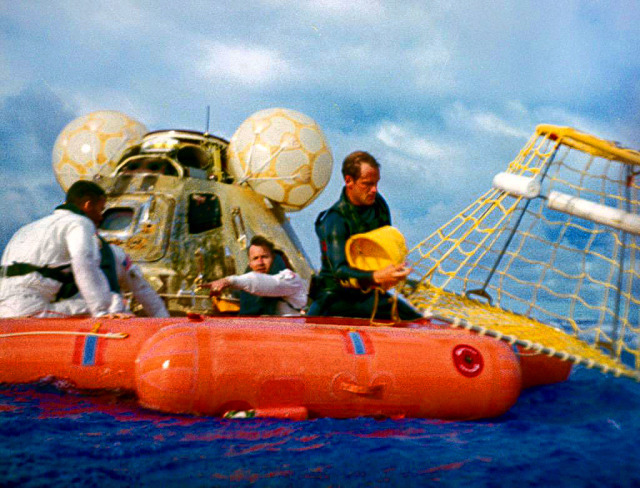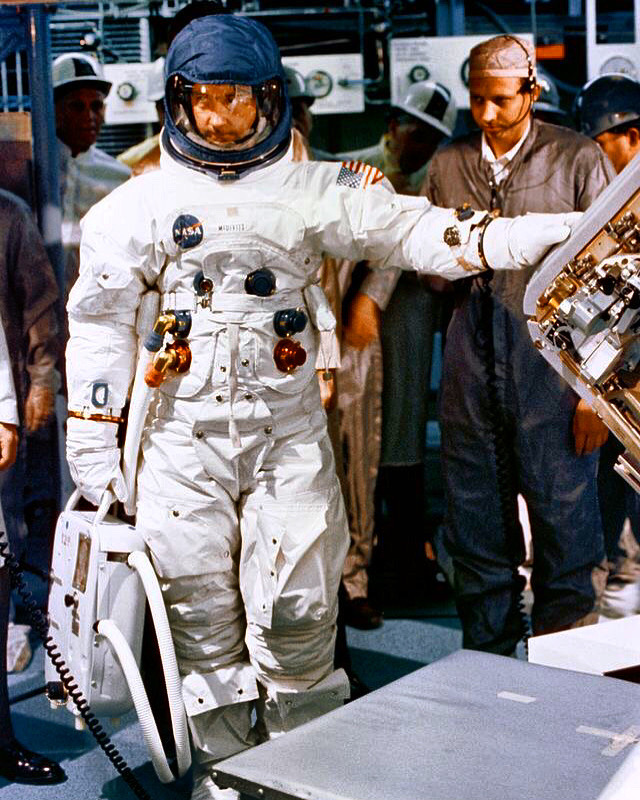#project apollo

What’s that out my window? A lunar rendezvous is in progress between the Command Service Module & Lunar Module during Apollo 10, May 1969. A10 was the 2nd mission to orbit the moon (after Apollo 8) & served as a dress rehearsal for a landing on the moon. The mission was flown by John Young, Tom Stafford & Gene Cernan. They flew the Lunar Module 8.4 nautical miles above the moon’s surface. This is the point where a powered lunar descent would commence. On the way home they set a speed record for a crewed spacecraft at 39,897 km/h (11.08 km/s or 24,791 mph); a record which still stands today.

Leaving for work. Apollo 15 was the 4th mission to land on the moon. Astronauts David Scott & James Irwin became the first to drive on the moon courtesy the Lunar Rover. The pair landed by Hadley Rille which was originally planned to be the landing spot for Apollo 19 before budget cuts nixed the mission. The Aug 1971 mission was Scott’s 3rd and final spaceflight while it was Irwin’s & Command Module Pilot Al Worden’s first and only. What a historic mission.

The incredible rescue. The Command Module of Apollo 13 floats with astronauts James Lovell, Fred Haise & Jack Swigert catching their breaths. A damaged wire had ignited on the Service Module following a stir of the oxygen tanks. The explosion left the astronauts’ supply of oxygen venting out into space. The Lunar Module then became the lifeboat for the 3. It was designed to support 2 men on the moon for 2 days; Mission Control though worked around the clock to improvise & create new procedures to allow it to support 3 men for 4 days. Just incredible. As always, I recommend director Ron Howard’s classic ‘Apollo 13’ for your viewing pleasure to see the full story.

A First Day Cover from Sept 9, 1969 commemorating the Apollo 11 moon landing. There’s a post stamp from the July 20 moon landing & a beautiful 10 cent stamp featuring Neil Armstrong stepping down upon the lunar surface. So many great space-themed stamps were designed by the USPS during the space age.

Setting up shop. The Lunar Module Antares has touched down upon the moon with the instruments set up during Apollo 14, Feb 1971. The mission was the first to land in the Lunar Highlands & the final ‘H-Mission’, or 2-day stay on the moon. After this, Apollo flights would be J-Missions, or 3-day lunar stays. This mission with Alan Shepard, Edgar Mitchell & Stuart Roosa was to take place in 1970 but was pushed back following an investigation into the explosion upon the Apollo 13 spacecraft.

Practice makes perfect. Neil Armstrong & Buzz Aldrin go through the steps with the Lunar Lander during preparation for Apollo 11, 1969. Backup crew for the first mission to the moon were Jim Lovell, Fred Haise & William Anders. Armstrong & Aldrin spent 21 & ½ hours at Tranquility Base before joining Command Module Pilot Michael Collins who was in lunar orbit in Columbia.

A vintage trading card wrapper from 1969 following the Apollo 11 moon landing. Just 5 cents for a pack of trading cards.

Parking is ample. The first to drive on the moon, David Scott, walks away from the Lunar Rover during Apollo 15, Aug 1971. Scott & fellow astronaut Jim Irwin spent 18.5 hours on EVAs during their lunar stay while Command Module Pilot Al Worden orbited above.

The road to the Vehicle Assembly Building at Kennedy Space Center. Completed in 1966, the VAB was originally intended for the vertical stacking of the Saturn V rocket during the Apollo Program era. During the Space Shuttle era, shuttle orbiters were mounted to fuel tanks & rocket boosters. The VAB is the tallest building (outside an urban area) in the US. It was the tallest building in Florida until 1974 & is the largest single story building in the world at 526 feet. At 129,428,000 cubic feet, it’s larger than your average 1-bedroom apartment.

Astronaut Neil Armstrong undergoes training prior to Apollo 11, 1969. Following his retirement from NASA in 1971, Mr. Armstrong went taught at the University of Cincinnati until 1979 in the Dep’t of Aerospace Engineering. During his space career, he also flew on Gemini 8 in 1966 & spent a total of 8 days & 14 hours in space during the two historic missions.

Where’s my drill? Astronaut David Scott retrieves a drill off the lunar surface during Apollo 15, Aug 1971. The mission was the first with the LRV (lunar rover vehicle). Mr. Scott was the 7th to walk on the moon & first to drive when he got behind the wheel of the LRV. He wa chosen in the 3rd Group of astronauts in 1963 & flew with Neil Armstrong on the historic & perilous Gemini 8 mission of 1966. He also flew on the 10-day Apollo 9 flight in 1969. David walked on the moon with James Irwin on A15 while Al Worden orbited above in the Command Module. The pair spent 18.5 hours on EVAs while on the moon’s surface & brought back 170lbs of moon rocks home.

Standing by. Astronaut James McDivitt readies for training during preparation for Apollo 9. Mr. McDivitt first flew on Gemini 4 with Ed White on a historic space flight in which White became the first American to space walk. Apollo 9 was a 10-day flight which McDivitt commanded and the first to employ the full Apollo spacecraft (the Lunar Module & Command & Service Modules). A9 was also the 2nd crewed flight with the Saturn V rocket. McDivitt was part of the Group 2 of astronauts selected in 1962.

Have camera, will travel. Apollo 12 astronaut Alan Bean does some work with the Hasselblad camera in preparation for the 2nd mission to land on the moon. Mr. Bean, chosen in the 3rd Group of astronauts by NASA in 1963, became the 4th person to walk on the moon during the Nov 1969 mission. He was 37 years old at the time. 4 years after A12, he flew on Skylab 3 in July 1973 on a mission which lasted 59 days. Also an accomplished painter, Bean created space-themed paintings of his adventures & of his fellow astronauts.

In the field today, on the moon tomorrow. Charlie Duke & John Young undertake geology training for Apollo 16 in Sudbury, Ontario, 07/71. The city in Northern Ontario, nicknamed ‘The Nickel City’, was chosen due to the area’s shatter cone formations. The pair landed in the Descartes Highlands upon the lunar surface in April the following year. They spent 71 hours on the moon & brought back ‘Big Mule’, for research; the largest moon rock collected during Project Apollo.

3 peas in a pod. Frank Borman sits in the commander’s seat to the left, with William Anders to the right & Michael Collins in the middle during flight simulator training for Apollo 8. Mr. Collins developed a back injury in 1968 which led to James Lovell replacing him on the 1st crewed flight to orbit the moon. All was not lost for Mike though as he was bumped back to Apollo 11 with Neil Armstrong & Buzz Aldrin for the first human landing on the moon. Not too bad of a second assignment.
With my older rendition of the Command Module Panel, just the CDR (Left seat) segment, getting some unexpected attention; I figured I would share again the completed panel. Larger Here.
Lots of changes and updates were made carrying the project on from the CDR panel. That was originally all I’d planned to do but as tribute to the all the hard work thousands of men and women poured into the real world spacecraft it was the least I could do to honor them. I began sometime mid 2017 and completed in 2018 nearly a year later. There’s better renditions out there, sure; but this one is mine.
Post link
KSC & MSC replica badges finally together after getting some proper materials. Finally happy with how these turned out!
Size and layout all referenced and accurate to their real-world counterparts!
Post link
Testing the mobility of an astronaut in a space suit at Wright-Patterson AFB
(Fritz Goro. 1962)
Post link





